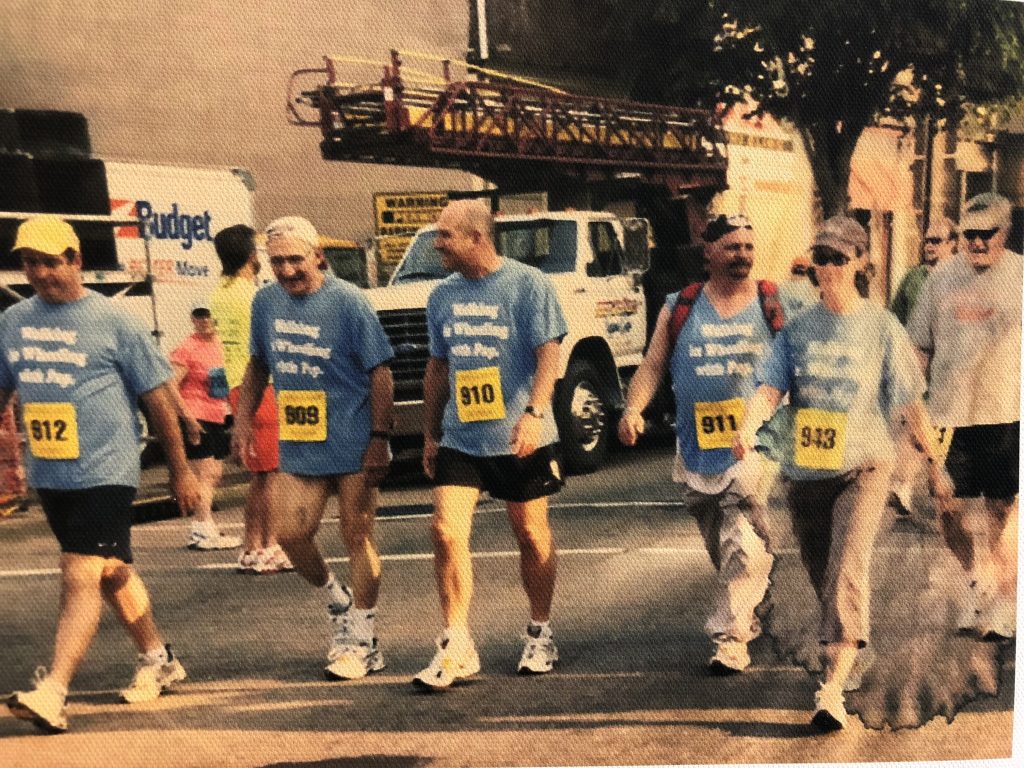9 Things Therapists Do When They
Want To Feel Happier

You can be an absolute expert within the field of finding happiness and still need a little help yourself.
“We have the same problems as our patients,” said David D. Burns, a clinical psychiatrist and author of bestselling psychology book Feeling Good: The New Mood Therapy. And sometimes that means dealing with negative thoughts, anxiety and bad moods.
So what does a therapist — usually the advice-giver when it comes to these types of problems — do when they’re in a funk? I loved falling across this HuffPost article who chatted with Burns and a few other experts to get their tips. Here are some of their go-to moves when they need to feel happy ASAP, as well as their advice on how you can steal them for yourself:
Use the “30-second rule”
If you’re feeling overwhelmed by a task, chore, conflict, to-do list ― and it’s totally sabotaging your mood ― try tackling just a small piece of it, Burns said. “The thing I choose to do has to be something I can complete in about 30 seconds, that way I can’t give myself any excuses to procrastinate,” he explained.
For example, Burns said that day he was feeling particularly overwhelmed by piles of paperwork on his desk, so he put his method into practice immediately. He took 30 seconds — all while on a call — to put a few pieces of paper together, staple them and file those papers properly in his file cabinet.
It’s ridiculously simple, but Burns said he felt a marked improvement in his mood immediately. “You feel a little bit of a boost every time you do this,” he said.
(I AM THE MOST UN-ORGANIZED ORGANIZED GUY I KNOW; I AM POWERFULLY PRODUCTIVE UNDER THE GUN AND AM IN CONSTANT COMPETITION WITH MYSELF; SO I PLAY THE GAME OF DOING JUST A LITTLE BIT MORE A LITTLE BIT LONGER AND A LITTLE BIT BETTER: WIN!)
Do some deep breathing

This tip is the oldest trick in the book for a reason. According to Habib Sadeghi, a holistic health expert and author of The Clarity Cleanse, taking a few large breaths can activate your parasympathetic nervous system, a part of your overall nervous system that’s responsible for lowering your heart rate and blood pressure. Taking a few deep breaths is also “a way to get out of the head and into the body,” Sadeghi said.
Sadeghi added that a deep-breathing exercise can be a small, easy way to slow down and change “how we think and feel.”
To try it yourself, start with a forceful exhale to clear some of the air from your lungs. Hold this for a second or two, then inhale deeply, allowing your abdomen to expand. Count to seven as you inhale, then hold your breath for about the same amount of time. Then exhale slowly for about 14 seconds or so. Repeat this for about 10 cycles, preferably on the edge of a chair with your eyes closed.
(WE NEVER THINK ABOUT BREATHING; SO THINK ABOUT IT. THE AVERAGE PERSON TAKES ANYWHERE FROM 17,280 TO 23,040 BREATHS A DAY. JUST THINK ABOUT 40 OF THEM ON PURPOSE)
LET YOURSELF FEEL BAD
It might be tempting to squash your terrible mood by suppressing that negativity, but you’re actually not doing yourself any favors. Instead, experts tell their patients ― and themselves ― to let themselves feel whatever emotions that pop up.
“Don’t tell your feelings to shut up. Instead, ask ‘what’s up?’” said Heidi Ligouri, a licensed counselor and motivational speaker. She added that ignoring a feeling can often make a situation worse.
Taking the time to process feelings can also help you get into a happier mindset more easily. There’s no reason to feel bad about feeling bad, said Kathleen Dahlen deVos, a psychotherapist based in San Francisco. She calls accepting negative feelings “emotional fluency,” which means experiencing your emotions “without judgment or attachment.” This allows you to learn from them, use them or move on from them more easily, Dahlen deVos said.
(SOMETIMES MONDAY FEELS LIKE A MONDAY; HUG THAT PORCUPINE AND REMIND YOURSELF THAT MONDAY IS ‘J U S T’ A DAY NOT ALL SEVEN; TUESDAY IS COMING AND SO IS THE WEEKEND!)
Stop and say one nice thing about yourself

Self-criticism comes easily for most people, especially when they’re in a terrible mood. So, once you’ve acknowledged you’re feeling crummy, counter that with a little emotional TLC.
“We tend to be so brutal on ourselves. Not only are we telling ourselves not to feel, but when we see a feeling we judge ourselves,” for having it, said Ligouri. “Once you see the [negative] feeling … practice self-compassion.”
If your bad mood is caused by a mistake, or if you’re thinking negatively about yourself, interrupt that stream of consciousness by picking out one thing you like about yourself. For example, maybe you prioritize hanging out with your sister, or you’re a team player at work, or you volunteer every month. Just something that gives yourself credit for your attributes. It sounds like a corny exercise, but it might just work.
“Developing a practice of mindful self-compassion has been hugely supportive in helping me to live a happier, healthier, and more joyful life,” Dahlen deVos said. “Self-compassion, in essence, is the recognition that no matter what is happening in our lives, we are innately worthy, lovable and connected to all of humanity.”
Still need some convincing that this technique isn’t bogus? Research shows that this practice also can help protect you from anxiety depression.
(MY GREATEST SELF TALK GO TO: I BELIEVE I AM THE BEST THERE IS; I BELIEVE IT WITH ALL OF MY HEART; B U T I ‘ K N O W’ IT’S NOT TRUE WHICH IS WHY EVERY DAY I JUST DON’T SEE MY FLAWS, I AM SEVERELY MOTIVATED TO DO SOMETHING ABOUT IT)
Ask yourself what you should do next ― then do it
Let’s say you showed up 20 minutes late to a meeting and halfway through your important presentation, you noticed you had a massive coffee stain on your shirt. You get through the meeting, but you’re angry about the circumstances afterward. In this situation, Ligouri said she figures out her next step by asking herself what she needed.
“Ask yourself: Do I want to keep rolling around in upset? Do I want to create or recreate a commitment to living a happy healthy life? Do I just need a nap? Do I want to reach out to a friend?” Ligouri said. In other words, figure out what to do next ― even if it’s just a simple task ― and then commit to doing it.
(SECRET WEAPON: M O T I O N–VERB IT UP! IT’S ALL ABOUT BEING IN MOTION/ACTING/DOING– EVEN IF IT’S IN YOUR HEAD)
Take a hike

Maybe not literally, but at the very least get outdoors. Each expert said they rely heavily on this activity as a way to improve mood.
“I make it a point to get fresh air and incorporate movement into every day,” Dahlen deVos said. “Sometimes this means a yoga or fitness class, but often it’s just a morning hike with my pup or an afternoon walk around the neighborhood during a free hour.” Her secret weapon? Doing this phone-free.
Aman also said long walks, in particular, are her go-to move when it comes to increasing her happiness. “I take a long walk in the woods,” she said. “The research on this is unmistakable. It’s good for the mind, body, and soul.”
You also get the added benefit of exercise, which is its own mood booster, Sadeghi said.
“Exercise is really one of the best ways to blow off stress and sadness,” he explained. “Even resistance training, or a rough round of racquetball or tennis — something that requires you to focus intensely on your body, its movements and sensations.”
(I WAS DEVASTATED TO EXPERIENCE THAT I COULD NO LONGER RUN MARATHONS OR EVEN SHORT DISTANCES BUT I CAN SWIM-RUN IN THE POOL AND STILL WALK–THE BEACH–ANY BEACH IS THE BEST; IT HAS IT’S HEALTH BENEFITS BUT I DO IT FOR MY HEAD NOT SO MUCH MY HEART)
Find a mantra that works when you’re in a bad mood
Dahlen deVos said she keeps a set of mantras in her back pocket, and recommends the same for her clients. “Develop a self-compassion mantra: an easy-to-memorize set of phrases to repeat when we need a compassion boost, or to create mindfulness of a situation,” she said.
She recommended trying something like this the next time you’re feeling down and out: “I’m having a hard time, but everyone feels this way sometimes. May I be gentle with myself and remember that I’m safe and okay.”
(MY GO TO : “I GOT THIS, BRING IT!”)
Dance it out
Sadeghi said he personally turns to dance as “a great way to expel a lot of pent-up anxiety or depressive energy.”
Using a mix of “upbeat songs that you really love,” give yourself room to literally dance like no one’s watching. “Make your movements random, but deliberate and strong; get your whole body into it,” he said. “Imagine the negative energy flying out of your body through your fingertips as you move around.”
(ok in my case: SING IT OUT, LOUD AND ANIMATED. MY FAVORITE PLAYLIST IS ONE I’VE CREATED CALLED: RUNNING; IT’S THE BEST WORKOUT I’VE HAD WITHOUT RUNNING SHOES)
Play with a pup (or another furry friend)

There’s a reason pet owners tend to live longer. Spending time with a dog, cat, or another animal can be profoundly calming and uplifting.
Burns cited time with his sweet rescue kitten Misty as one of his all-time favorite mood-boosters.
“It really teaches me something at a deep level,” he said. “She’s not special, she’s just an abandoned cat. I am not special either! But when we’re together, life becomes special.”
(I’VE TOLD MY DOG AND CATS THINGS I’VE NEVER TOLD ANOTHER LIVING BEING AND THEY’VE NEVER DISAPPOINTED OR NOT LISTENED OR NOT BEEN GLAD TO SEE ME–B A M!)
Psssssssssssssssssst:
Sometime this Clown doesn’t much like Clowning. . .
It, thankfully, never lasts long because of the ultimate secret weapon:

Leave a Reply